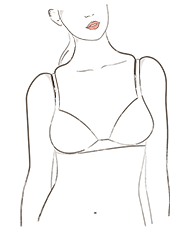Returns & exchanges free for 60 days for all U.S. orders. Please try on the bra to ensure a good fit, making sure to leave the original tags attached. We only accept underwear in unworn condition, with original tags, in its unopened original polybag. Items marked final sale are not eligible for return or exchange. If something’s not right, we can help. Our Fit Experts are available via live chat, or email to answer any questions you might have.
Read moreCommon Bra Fit Issues: And How to Solve Them
At ThirdLove, our goal is to help women everywhere find their perfect fit. But we know it’s not always that simple - there are many common fit issues that stand in the way of finding the best bra for you.
Ever experienced bra fit issues? Read on as we identify some of the most common ones (and their solutions) to help you find a new size that will make you feel great.

How to put on a bra
Before we dive into fit issues, let’s talk about how to put on a bra. Seems like a no-brainer, but putting on your bra the right way can immediately alleviate some fit issues you may be having.
First, we suggest wearing your bra on the loosest hook so that as it stretches out over time you can make it tighter. Next, try what we call the “scoop & swoop”. Get your breasts in the right place by gathering each breast into the cups as you pull back on the wire.
Lastly, tighten the straps every other month to keep them snug and supportive. Over time, they can loosen (resulting in a poor fit), so doing this ensures you have a perfect fit every time.

Now that you’re up to speed on how to properly put on a bra, here are some common fit issues we hear - and our solutions:
Do you have slipping straps?

To fix slipping straps, try tightening your bra straps, if you haven’t already. Straps can stretch out over time, so we suggest doing this every other month or so.
If tightening your straps doesn’t do the trick, take a look at the style of bra you’re wearing. Did you know that certain styles (Full Coverage, Demi and Convertible bras) typically have narrow set straps that help keep them on your shoulders throughout the day? Other styles, like Balconette and Plunge bras, have wider set straps and can slip more easily depending on your body type. Take a look at our Bra Style Guide to identify the style you should be wearing.
Are your straps digging in?

Contrary to popular belief, your bra straps should not be doing all of the heavy lifting - your bra brand should be doing most of the work. If your straps are digging into your shoulders, chances are your band is too big or has stretched out over time. If this is happening to you, consider buying one band size smaller - that might do the trick. (Remember: if you buy a smaller band size than usual, you need to go up one size in your cup. Example, if you’re currently a 36C, your tighter band would be 34D. View our Size Chart to learn more!)
Lastly, if you’re a D cup or bigger, we suggest buying a style of bra with narrower straps, like our 24/7™ Full Coverage Bra, so that the straps are centered on your shoulders and the weight of your breasts is evenly distributed.
What about gaping cups?

This is a common issue for women with East West, Asymmetric, Bell Shape or Slender breast shapes (check out our Breast Shape Dictionary to identify your breast shape). Typically, these women’s breasts rest at the bottom of their cups, leaving room at the top for cup gaping.
If this is happening to you, try tightening your bra straps. If that doesn’t work, go down a cup size - your cup may be a little too big. If you don’t think you’re an entire cup size smaller, consider one of our half-cup sizes (our Fit Finder™ can help you identify if half-sizes may be right for you).
If your cups fit well but there’s still room at the top for gaping, consider a Plunge or Push-Up style to push your breasts upwards. These cups tend to be cut a little smaller to reduce gaping in the first place.
If you have side overflow, we can help.

Ever had your breasts spill out of the sides of a cup? That’s a surefire sign that your cups are too small. This is probably the easiest bra fit issue to fix - just size up in the cup.
Or, if your band doesn’t feel tight enough, you might need to size up in the cup and down in the band. A snug band will pull the wire in your bra back, and allow your breasts to sit in the cup where they belong.
Here’s how to deal with cup overflow:

Similar to side overflow, cup overflow is easy to fix: trade in for a bigger cup size and give your breasts some much-needed breathing room! If you’re a 34B, trade up a half-size to 34B ½ or a whole cup size to 34C if you need it. You (and your breasts) will breathe a sigh of relief.
Wire sitting on your breasts? It shouldn’t be.

Sometimes, we speak to women whose wires are sitting on their breasts. This is a sign of your band being too big - you need to invest in a smaller band size to tighten the fit. (Remember: if you size down in band size, you need to go up in cup size, so that your breasts still have room to breathe. For more information on how this works, check out our Size Chart.)
Not seeing your fit issue? Contact us!
Tags: